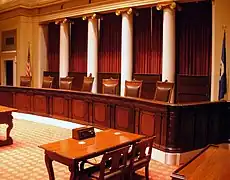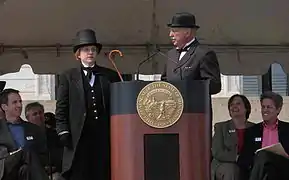| Minnesota Supreme Court | |
|---|---|
 | |
| Established | May 24, 1858 |
| Location | Saint Paul, Minnesota |
| Composition method | Nonpartisan election, appointment by the governor if filling midterm vacancy |
| Authorized by | Minnesota Constitution |
| Judge term length | 6 years (mandatory retirement at the age of 70) |
| Number of positions | 7 |
| Website | Official website |
| Chief Justice | |
| Currently | Natalie Hudson |
| Since | October 2, 2023 |
| Jurist term ends | January 31, 2027 |
 |
|---|
| Constitution |
The Minnesota Supreme Court is the highest court in the U.S. state of Minnesota. The court hears cases in the Supreme Court chamber in the Minnesota State Capitol or in the nearby Minnesota Judicial Center.
History
The court was first assembled as a three-judge panel in 1849 when Minnesota was still a territory. The first members were lawyers from outside the region, appointed by President Zachary Taylor. The court system was rearranged when Minnesota became a state in 1858.
Appeals from Minnesota District Courts went directly to the Minnesota Supreme Court until the Minnesota Court of Appeals, an intermediate appellate court, was created in 1983 to handle most of those cases. The court now considers about 900 appeals per year and accepts review in about one in eight cases.[1] Before the Court of Appeals was created, the Minnesota Supreme Court handled about 1,800 cases a year. Certain appeals can go directly to the Supreme Court, such as those involving taxes, first degree murder, and workers' compensation.
Composition
The seven justices of the Minnesota Supreme Court are elected to renewable six-year terms.[2] When a midterm vacancy occurs, the governor of Minnesota appoints a replacement to a term that ends after the general election occurring more than one year after the appointment.[3] Most vacancies occur during a term. The most recent election to an open seat on the court was in 1992, when former Minnesota Vikings player Alan Page was elected. Judges in Minnesota have a mandatory retirement age of 70.[4][5]
Anne McKeig, a descendant of the White Earth Band of Ojibwe, became the first Native American justice in 2016. Her appointment also marked the second time the court had a majority of women since 1991.[6]
In May 2020, Governor Tim Walz announced the appointment of Nobles County District Judge Gordon Moore, who replaced retiring Justice David Lillehaug.[7]
Salary
The salary for the Supreme Court Chief Justice is $205,362 and $186,692 for associate justices.[8]
Members
| Seat | Justice[9] | Born | Joined | Term ends | Mandatory retirement[lower-alpha 1] | Appointed by | Law school |
|---|---|---|---|---|---|---|---|
| Chief Justice | Natalie Hudson | January 13, 1957 | October 26, 2015 (as Associate Justice) October 2, 2023 (as Chief Justice) |
2028 | January 31, 2027 | Tim Walz (D)[lower-alpha 2] | Minnesota |
| 1 | Barry Anderson | October 24, 1954 | October 13, 2004 | 2024 | October 31, 2024 | Tim Pawlenty (R) | Minnesota |
| 2 | Margaret Chutich | June 18, 1958 | March 17, 2016 | 2024 | June 30, 2028 | Mark Dayton (D) | Michigan |
| 5 | Anne McKeig | February 9, 1967 | August 31, 2016 | 2024 | February 28, 2037 | Mark Dayton (D) | Hamline |
| 4 | Paul Thissen | December 10, 1966 | May 14, 2018 | 2026 | December 31, 2036 | Mark Dayton (D) | Chicago |
| 3 | Gordon Moore | April 6, 1963 | August 3, 2020 | 2028 | April 30, 2033 | Tim Walz (D) | Iowa |
| 6 | Karl Procaccini | 1982 or 1983 (age 40–41) | October 2, 2023 | 2024 | 2052/2053 | Tim Walz (D) | Harvard |
- ↑ Justices must retire at the end of the month in which they reach the age of 70.
- ↑ Originally appointed by Governor Mark Dayton (D) as Associate Justice. Subsequently appointed by Governor Tim Walz (D) as Chief Justice.
Vacancy and pending nomination
| Seat | Seat last held by | Vacancy reason | Date of vacancy | Nominee | Date of nomination |
|---|---|---|---|---|---|
| — | Barry Anderson | Retirement | May 10, 2024[10] | – | – |
| — | Margaret Chutich | July 31, 2024[11] | – | – |
Images
 Minnesota State Capitol Supreme Court chamber
Minnesota State Capitol Supreme Court chamber The historic court chamber seen from the side
The historic court chamber seen from the side Justices portray predecessors on Statehood Day
Justices portray predecessors on Statehood Day The Minnesota Judicial Center
The Minnesota Judicial Center
Important cases
- Baker v. Nelson, 291 Minn. 310, 191 N.W.2d 185 (1971), in which the Court held that denial of the statutory entitlement demanded by gay citizens to marry the adult of one's choice does not offend the United States Constitution; overturned by Obergefell v. Hodges, 576 U.S. 644 (2015).
- Doe v. Gomez, 27 Minn. 542 N.W.2d 17 (1995), in which the Court held that on-demand abortion in the state is constitutional.
See also
References
- ↑ "Supreme Court" (PDF). Minnesota Judicial Branch. Retrieved February 20, 2014.
- ↑ "Minn. Const. art. VI, sec. 7". Minnesota Constitution. Office of the Revisor of Statutes. Retrieved February 20, 2014.
- ↑ "Minn. Const. art. VI, sec. 8". Minnesota Constitution. Office of the Revisor of Statutes. Retrieved February 20, 2014.
- ↑ "Minnesota Statutes 2013, section 490.121, subdivision 21d". Office of the Revisor of Statutes. Retrieved February 20, 2014.
- ↑ "Minnesota Statutes 2013, section 490.121, subdivision 1". Office of the Revisor of Statutes. Retrieved February 20, 2014.
- ↑ Lopez, Ricardo (June 28, 2016). "Dayton selects McKeig as next Supreme Court justice". Star Tribune. Retrieved September 6, 2016.
- ↑ Montemayor, Stephen (May 16, 2020). "Gov. Walz makes Worthington judge his first Minnesota Supreme Court selection". Star Tribune. Retrieved June 11, 2020.
- ↑ "Minnesota Judicial Branch - How to Become a Judge". www.mncourts.gov. Retrieved March 29, 2021.
- ↑ "Minnesota Supreme Court". Minnesota Judicial Branch.
- ↑ Halbach, Ashley (January 11, 2024). "Minnesota Supreme Court Justice announces retirement". KSTP-TV.
- ↑ Tribune, Rochelle Olson Star. "Justice Margaret Chutich announces retirement from Minnesota Supreme Court". Star Tribune. Retrieved January 16, 2024.